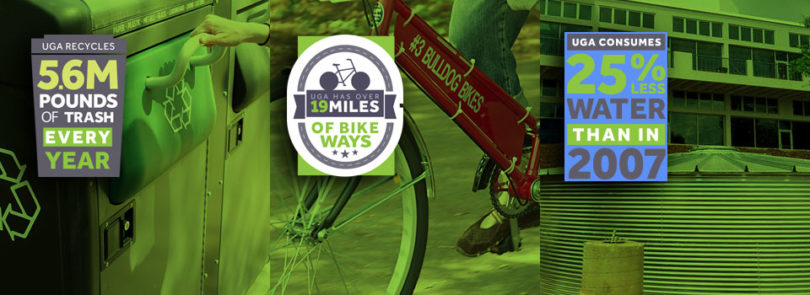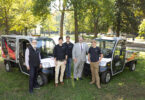Big sustainability projects draw attention at the University of Georgia-like newly constructed LEED-certified residence halls on East Campus and the campus tree program that in 2013 added 145 trees to the 9,000-plus already on campus.
But it’s the small steps that are making a daily impact as the university increases its eco-friendly footprint-small steps that lead to more resources saved, less water used, fewer kilowatts wasted and more green spaces dotting campus.
Since UGA students voted in 2009 to spend a part of their tuition dollars on an Office of Sustainability through a self-imposed “student green fee,” initiatives across campus have taken root.
Now, solar panels power computers in the Jackson Street Building, home of the College of Environment and Design. Bins in academic and residential buildings throughout campus increase the amount of paper, plastic, glass and metal headed toward recycling facilities instead of the landfill. Low-flow toilets save valuable water, and updated electronics equipment saves time and electricity.
In residence halls, students compete annually to see which is the best at waste reduction through a program called RecycleMania. They also try to lower their water and energy use over the previous year’s numbers through the Green Cup Competition. And as students move off campus each summer, they keep furniture and other reusable items out of the trash through an initiative known as Dawgs Ditch the Dumpster.
“Since our office started in 2009, we’ve seen incredibly innovative ideas spring up across campus,” said Kevin Kirsche, director of the Office of Sustainability. “You can walk the length of a football field anywhere at UGA and see multiple examples of how we’re ‘greening up’ the university.”
This year on April 29-Reading Day for UGA students-the university will hold a “Spring Semester in Review: Creating a Culture of Sustainability at UGA” from 11 a.m. to 1 p.m. in the Richard B. Russell Building Special Collections Libraries. The event will be an opportunity for engagement, collaboration and a shared celebration of projects and initiatives that have taken place this semester to further sustainability. A light lunch will be provided. To RSVP for the event, see http://www.eventbrite.com/e/spring-semester-in-review-creating-a-culture-of-sustainability-at-uga-tickets-11034637899.
As the university moves forward with its focus on sustainability as part of its 2020 strategic plan, it will continue to find new ways to green up its environment. Below are a few of the most recent.
Updating and saving
For decades, the Boyd Data Center has been the secure home of the University of Georgia’s technology systems for IT services that must operate on a 24/7 basis. Now, the professionally managed data center is saving the university substantial energy costs.
“The Boyd Data Center is the IT backbone for UGA because it houses the computer systems and networks necessary to operate the institution for students, faculty and staff for research, academic and administrative purposes,” said Timothy M. Chester, vice president for information technology. “But, it takes a lot of energy to not only operate the infrastructure in any data center, but also to keep the equipment cool.”
Since Chester arrived at UGA almost two years ago, the Boyd Data Center has undergone a significant physical transformation to remove outdated equipment, invest in more efficient technologies and take steps to reduce the facility’s carbon footprint.
The changes have resulted in a current $134,000 annual savings in energy costs to the university.
Taking advantage of cloud-based services, such as those for email and its learning management system, the university has been able to decommission legacy servers in the Boyd Data Center. Meanwhile, it has also been leveraging newer virtual technologies for IT systems.
Boyd Data Center staff members have been carefully removing long-abandoned cables and wires beneath the facility’s raised floor and recycling the materials. A machine that safely and securely destroys old hard drives from servers and desktop computers further allows the staff to recycle scrap metal and plastic.
Cleaning up ‘stinky creek’
Students in the UGA environmental practicum gain hands-on experience solving environmental problems for stakeholder clients-usually local governments, state agencies or non-governmental organizations-across the state. Recently, however, they have been working for a client much closer to home. Since 2011, they have been helping the university restore the health of Lilly Branch, a stream that flows through campus.
Lilly Branch is 2.5 miles long and feeds the North Oconee River. It rises just south of Five Points and for much of its length flows beneath UGA in a pipe before emerging at the Lamar Dodd School of Art. Its long history of impairment is reflected in its former nickname, “Stinky Creek.” The stream’s distinctive odor prompted water sampling by students in the Warnell School of Forestry and Natural Resources, which led to the discovery that the creek had so much fecal coliform bacteria that it failed state water quality standards.
“Once we knew that the stream was impaired, the question was, what can we do about it?” said Laurie Fowler. Fowler, associate dean of the Odum School and co-director of the UGA River Basin Center, directs the environmental practicum. She said that this problem, requiring a mix of scientific, legal and design expertise, was tailor-made for the class.
In collaboration with the Office of Sustainability, the College of Agriculture and Environmental Sciences, the College of Environment and Design, the Office of the University Architect and the Facilities Management Division at UGA and the Athens-Clarke County departments of storm water and public utilities, practicum students set to work.
Their first step was to develop a comprehensive watershed management plan. They then identified many sources of fecal coliform pollution, including drainpipes from apartment complexes, unchecked storm water runoff from parking lots, dog waste and leakage from dumpsters and underground sewer pipes. They found other problems as well, such as severe bank erosion and invasive species. They then proposed a set of management strategies to address each of the issues identified.
Subsequent classes have started implementing those strategies. And ongoing monitoring shows that health of Lilly Branch is improving-but still has a long way to go. Fortunately, students in future environmental practicum classes will be on the job to help UGA manage campus streams in a sustainable manner.
Sun-powered trash compactors
In September 2013, the UGA Facilities Management Division installed 30 solar-powered mixed-recycling and landfill compactor stations-called BigBelly bins-at high-traffic locations on the Athens campus. In general, all paper, plastic, metal and glass items go in the recycling bin; food wrappers, food waste and Styrofoam items go in the trash.
The new system replaced 150 existing trash cans and has helped increase recycling in these areas from less than 2 percent to 47 percent of items captured and diverted. At this rate, the project will divert more than 56,000 pounds of additional materials from the Athens-Clarke County landfill each year.
The solar-powered waste reduction stations are increasing recycling and reducing university costs-through avoided landfill tipping fees, redirected staff time and reduced fuel use. The time required to collect and transport materials in the project area has been reduced by more than 90 percent, from 30 hours per week to only 2.5 hours per week, allowing UGA employees to focus on other concerns.
“BigBelly bins enable just-in-time collection, saving us labor, time and fuel while ensuring there are no overflow issues on the campus,” said Tom Satterly, assistant vice president for the Facilities Management Division. “Implementing a winning ‘human-plus-machine’ strategy, the division is freeing up time for our staff to perform other valuable tasks.”
A barn’s worth of projects
Snyder Barn-which once housed horses in its location near the corner of College Station and Barnett Shoals roads-lives on in its pieces. The building was demolished in January 2013 to make way for the new UGA Veterinary Medical Learning Center.
“A majority of the building was either recycled or reused,” said Chris McDowell, who coordinates the Material Reuse Program within the College of Environment and Design. The program diverts construction and demolition waste materials and reuses them in landscape projects.
The barn’s metal walls were recycled, and McDowell estimates approximately 70,000 pounds of barn materials and fencing were reclaimed. Only about 10 percent of the building-including contents like fiberglass and insulation foam-was not reused.
The materials from the Snyder Barn are continuing to be used in more than a dozen projects, including community space-in the form of container gardens-through Casa de Amistad; a bird blind at Panola State Park in Stockbridge; a pavilion built for compost at the Athens-Clarke County Recycling Center; edging for a nature walk at Hill Chapel Baptist Church in Athens; and an arbor at a new park coordinated through Habitat for Humanity and the student-run Landscape Architecture conference LABash 2013 held at UGA.
Other pieces of Snyder Barn made their way to Rose Creek, a College of Veterinary Medicine farm in Oconee County. These include stall doors, pasture gating and fencing, a grain silo and feeders.






